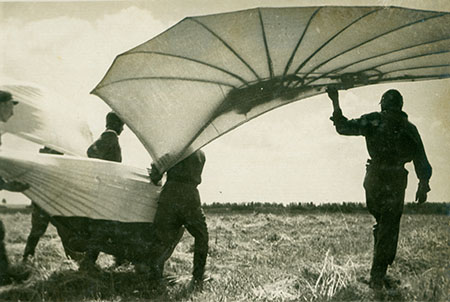Vladimir Tatlin

Vladimir Tatlin – an absurdist artist? In the west, many see Tatlin as a key founding figure of rational, materialist art. But for his friend, Russian theorist Nikolay Punin, Tatlin’s Monument to the Third International of 1920–21 (the wooden model was painted red, incidentally, not unpainted as the many replicas suggest) was an ‘ideological absurdity’.
This idea seems less far-fetched, however, after a careful exploration of the exhibition ‘Tatlin – New Art for a New World’, curated by Gian Casper Bott. It is the most comprehensive show of the artist’s work to date, including his early drawings and paintings (which fuse Russian tradition and French Modernism), his ‘counter-reliefs’ (three-dimensional, Cubist-influenced abstractions from 1914) and the Monument which arose from them, the Letatlin of 1930–32 (a muscle-powered flying machine recalling the designs of Leonardo da Vinci); his tender figurative paintings, dating from after 1930, came as a surprise to all those who had expected Tatlin to stick to Constructivism. Finally, the show offers the first extensive documentation of Tatlin’s work for the theatre, showing him in a new light.
As early as 1911, Tatlin was involved in the production of Boris Tomashevsky’s revised version of the traditional Russian drama Tsar Maximilian and his Unruly Son Adolfa. Pieced together from oral accounts of the original play, it was staged like a fairground show with participation from the Moscow audience.The exhibition includes Tatlin’s designs, which are clearly based on folk culture motifs.
Key to Tatlin’s understanding of art, however, was his support for the performance of the ecstatic poem Zangezi (1922) by Velimir Khlebnikov, large parts of which are written in an invented language of gods and birds. The exhibition also includes a contract from 1917 securing Tatlin’s involvement in a production of Khlebnikov’s satire, Mrs. Lenin, which earned Khlebnikov an arrest warrant; fleeing the police, he died of starvation in 1922. In spite of this, Tatlin managed to stage the work in 1923. Like Kazimir Malevich, Tatlin was a great admirer of Khlebnikov. A talented wordsmith who drew on folk traditions, Khlebnikov’s linguistic acrobatics, evident in poems such as Incantation by Laughter (1908–09), remain unparalleled and unique, while his performances as the self-declared ‘Chairman of The Globe’ anticipated the later actions of Dada.
Zangezi was premiered in 1923 at the GINCHuK Museum of Art and Culture in Petrograd – where, from 1928 on, Khlebnikov’s successors, the literary absurdists of the OBERIU group (a Russian acronym for ‘The Union of Real Art’), were active. The group’s leader Daniil Kharms developed a theory of the object connected to the idea of free will, writing: ‘Such an object “LEVITATES”.’ Tatlin illustrated Kharms’s absurdist fairytale First, Second (1928), and parallels can be drawn to his flying machine Letatlin or to his plan, reported by fellow artist Yuri Annenkov, to place a beating heart inside his spiral-shaped Monument to create an ‘animated machine’.
The notion that Tatlin’s objects should always be understood as part of his actions was already suggested by Punin’s biography Tatlin (Against Cubism) (1921). According to the artist Vladimir Milashevsky, even the Monument served as a stage set for absurdist dinners where the guests sat in a circle with their backs to the sculpture, able neither to see the object nor to engage in conversation. Tatlin’s life seems to have been rich in absurd acts. Like Kharms, he believed in levitation, posed as a blind man while singing folksongs, worked for years on a flying machine that could not fly, set up chairs that could not be sat on, and went about in fancy dress (as did Malevich). The German Dadaist George Grosz, who visited Tatlin, called him the ‘great jester’ and told of chickens running about his studio.
The exhibition in Basel offers an amazing wealth of material that hints at Tatlin’s absurdist leanings. However, by not making them an explicit theme, an opportunity was missed to counter the still-predominant reading of his work ignoring these leanings, which resulted chiefly from his objects being taken out of their performative contexts, thereby allowing various theorists to project their own interpretations onto them. And this despite the fact that John E. Bowlt, one of the leading experts in modern Russian culture, had already highlighted the absurdist dimension of Tatlin’s work in the publication accompanying the artist’s last major show at the Kunsthalle Düsseldorf in 1993: ‘There is much in Tatlin’s biography to suggest that he was, in many respects, a Dadaist or, more precisely, an absurdist and that his basic aesthetic instinct led him to invent non-objects and purely fantastical products rather than objects for the new revolutionary reality.’
















